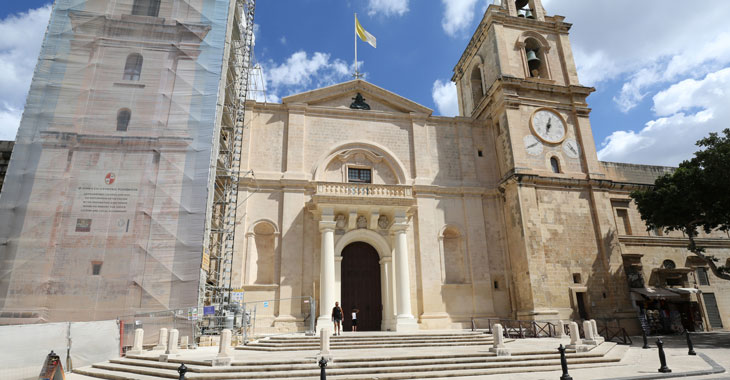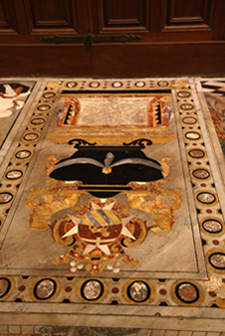Day 3 - St. John's Co-Cathedral and Fort St. Elmo
The celebratory dinner in the walled city of Mdina was scheduled for the evening of Day 3 so we decided
not to venture too far afield. Anyway, there were still many museums and places
of interest to explore in Valletta.
We headed first to St. John's Co-Cathedral. Note the 3 clocks on the steeple on the right. One shows the time,
one shows the day of the week, and the third shows the date.
The Knights of St. John, comprised of noblemen from the most important families of Europe, was a Roman Catholic
religious order charged with protecting the Christian world from Barbary pirates and the Turkish Ottoman
Empire. They had been headquartered in Rhodes, but the Turks, led by Suleiman the Magnificent, drove them
out in 1522. They wandered from place to place in Europe until Charles V, the Holy Roman Emperor, gave them
the island of Malta for a fee of one falcon a year. The Turks planned to take Malta because its strategic
location would make it an excellent base for conquering Europe, and Charles hoped that the presence of the
Knights would deter Suleiman.
Charles' tactic paid off
in 1565, the summer of the Great Seige, when the Ottoman Turks invaded. Although the Knights were greatly
outnumbered, they had prepared by building up the 3 forts in the harbor - St. Angelo, St. Michael, and St.
Elmo; stretching a great chain across the harbor entrance to keep enemy vessels out; and stockpiling food,
water and arms. Against all odds and assisted by the ordinary people of Malta, the Turks were repelled.
After the victory, the knights were richly rewarded by the monarchs of Europe, and the new city of Valletta
took shape.
The original St. John's Co-Cathedral was built between 1573 and 1578, and the interior at that time was
very plain and modest. Later, in the 17th Century, the interior was redesigned to the grandiose baroque
style that exists today.
The Knights were organized into 8 langues according to the areas of Europe they represented, and each of the
langues has a chapel dedicated to its patron saints.
The remains of over 400 Knights are entombed beneath the ornate marble floor pictured below.
Caravaggio's largest painting, Beheading of St. John the Baptist, is on display in the Oratory, but you are not
allowed to take photographs there. I was more impressed by this bronze by Alessandro Algardi which was once
part of a statue that stood at the Grand Harbor.
We wandered down the steep hill at the end of Republic Street and came upon Fort St. Elmo. The fort now houses
the National War Museum and, although we generally avoid war museums, this one proved to be
quite interesting. There were many audio visual displays that traced the entire history of Malta back to
prehistoric times. There were also some terrific views from the fort.
The picture on the left below is the Porta del Soccorso, one of the two entrances to the old fort. Note the eye of
Osins, an image commonly found on the small Maltese fishing boats called luzzus.
If you look closely at the foreground in the picture on the right, you will see what was once the opening to a granary where
food was stored in preparation for the Seige of Malta.
Fort St. Elmo Parade Grounds surrounded by barracks.
Looking back towards Valletta.
Here's a picture that encompasses both old and new Malta.
We didn't quite make it through the World War II exhibits because party time was approaching.


















